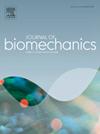对生长期大鼠后肢悬吊和随后长期重装后的运动模式进行三维分析。
IF 2.4
3区 医学
Q3 BIOPHYSICS
引用次数: 0
摘要
目前还不完全清楚生长期体重负荷不足对运动模式的长期影响。本研究的目的是利用跑步机和三维(3D)运动分析系统确定:1)骨骼尚未发育成熟的大鼠后肢悬吊(HS)对运动模式的影响;2)运动模式与股骨形态之间的关系。对四周大的雌性大鼠进行为期四周或八周的 HS 治疗,然后进行重装治疗,直至大鼠长到 54 周大。年龄匹配的未接受治疗的大鼠作为对照组。运动分析表明,4周和/或8周的HS会导致大鼠在迈步时骨盆在前方平面的摆动增加、髋关节内收角减小,以及在重新加载后1周和5周的负荷反应阶段脚趾外展(足外展角增大)。有趣的是,八周的 HS 导致的髋关节内收角减小和脚趾外展现象甚至在 54 周龄时仍然存在。皮尔逊相关分析表明,髋关节内收角与股骨内翻角之间存在很强的相关性(r = -0.78),髁内/外侧高度(髁大小不对称的指标)与趾外翻角之间存在中等程度的相关性(r = 0.66)。这些结果表明,生长过程中体重负荷不足可能会通过股骨形态异常诱发运动模式异常,这种异常可能会长期存在。本文章由计算机程序翻译,如有差异,请以英文原文为准。
Three-dimensional analysis of locomotion patterns after hindlimb suspension and subsequent long-term reloading in growing rats
The long-term effects of insufficient weight loading during growth on locomotion patterns are not fully understood. The purpose of this study was to determine 1) the effects of hindlimb suspension (HS) in skeletally immature rats on locomotion patterns using a treadmill and a three-dimensional (3D) motion analysis system, and 2) the relationships between locomotion patterns and femoral morphologies, which were reconstructed from 3D computed tomography images taken at 54 weeks old. Four-week-old female rats were subjected to HS four or eight weeks, followed by reloading for until reaching up to 54 weeks old. Age-matched untreated rats served as controls. Motion analysis revealed that four and/or eight weeks of HS resulted in increased pelvis oscillation in the frontal plane during steps, decreased hip adduction angle, and toe-out (increased foot abduction angle) during the load response phase at one and five weeks after reloading. Interestingly, the decreased hip adduction angle and toe-out induced by eight weeks of HS persisted even at 54 weeks old. Pearson’s correlation analysis revealed a strong relationship between the hip adduction angle and femoral anteversion angle (r = -0.78) and a moderate relationship between the medial/lateral condyle height (an index of asymmetric condyle size) and toe-out angle (r = 0.66). These results suggest that insufficient weight loading during growth may induce abnormal locomotion patterns via abnormal femoral morphologies that may persist over time.
求助全文
通过发布文献求助,成功后即可免费获取论文全文。
去求助
来源期刊

Journal of biomechanics
生物-工程:生物医学
CiteScore
5.10
自引率
4.20%
发文量
345
审稿时长
1 months
期刊介绍:
The Journal of Biomechanics publishes reports of original and substantial findings using the principles of mechanics to explore biological problems. Analytical, as well as experimental papers may be submitted, and the journal accepts original articles, surveys and perspective articles (usually by Editorial invitation only), book reviews and letters to the Editor. The criteria for acceptance of manuscripts include excellence, novelty, significance, clarity, conciseness and interest to the readership.
Papers published in the journal may cover a wide range of topics in biomechanics, including, but not limited to:
-Fundamental Topics - Biomechanics of the musculoskeletal, cardiovascular, and respiratory systems, mechanics of hard and soft tissues, biofluid mechanics, mechanics of prostheses and implant-tissue interfaces, mechanics of cells.
-Cardiovascular and Respiratory Biomechanics - Mechanics of blood-flow, air-flow, mechanics of the soft tissues, flow-tissue or flow-prosthesis interactions.
-Cell Biomechanics - Biomechanic analyses of cells, membranes and sub-cellular structures; the relationship of the mechanical environment to cell and tissue response.
-Dental Biomechanics - Design and analysis of dental tissues and prostheses, mechanics of chewing.
-Functional Tissue Engineering - The role of biomechanical factors in engineered tissue replacements and regenerative medicine.
-Injury Biomechanics - Mechanics of impact and trauma, dynamics of man-machine interaction.
-Molecular Biomechanics - Mechanical analyses of biomolecules.
-Orthopedic Biomechanics - Mechanics of fracture and fracture fixation, mechanics of implants and implant fixation, mechanics of bones and joints, wear of natural and artificial joints.
-Rehabilitation Biomechanics - Analyses of gait, mechanics of prosthetics and orthotics.
-Sports Biomechanics - Mechanical analyses of sports performance.
 求助内容:
求助内容: 应助结果提醒方式:
应助结果提醒方式:


